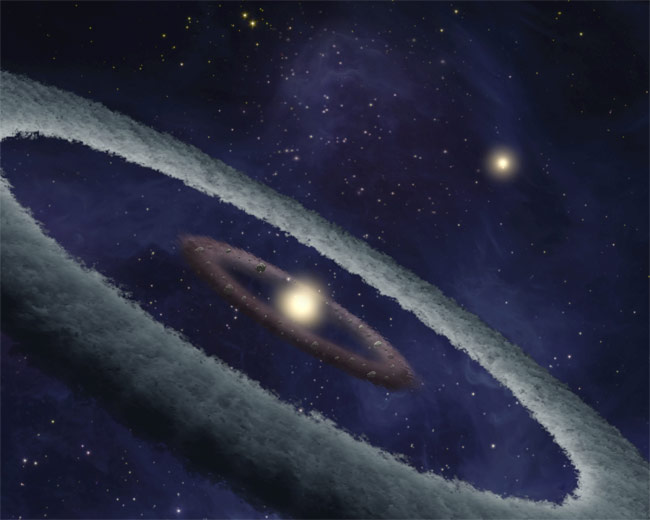
Astronomers have spotted evidence of a second Earth being built around a distant star 424 light-years away.
Using NASA's Spitzer Space Telescope, astronomers have spotted a huge belt of warm dust swirling around a young star called HD 113766 that is just slightly larger than our sun. The dust belt, which scientists suspect is clumping together to form planets, is located in the middle of the star system's terrestrial habitable zone where temperatures are moderate enough to sustain liquid water. Scientists estimate there is enough material in the belt to form a Mars-sized world or larger.
At approximately 10 million years old, the star is just the right age for forming rocky planets, the researchers say. Their finding will be detailed in an upcoming issue of Astrophysical Journal.
"The timing for this system to be building an Earth is very good," said study team member Carey Lisse of the Johns Hopkins University Applied Physics Laboratory in Baltimore, Md.
If the star system were too young, the planet-forming disk would be full of gas, and it would be making gas-giant planets like Jupiter instead. If it were too old, Spitzer would have spotted rocky planets that had long ago formed.
The star system also has the right mix of dusty materials in its disk to form an Earth-like planet, Lisse said.
Using Spitzer's infrared spectrometer instrument, the team determined that the material around HD 113766 is more processed than the snowball-like stuff that makes up infant solar systems and comets, which are considered cosmic "refrigerators" because they contain pristine ingredients from the solar system's formative period. But it is also not as processed as the stuff found in mature planets and asteroids.
Get the Space.com Newsletter
Breaking space news, the latest updates on rocket launches, skywatching events and more!
"The material mix in this belt is most reminiscent of the stuff found in lava flows on Earth," Lisse said. "I thought of Mauna Kea [in Hawaii] material when I first saw the dust composition in this system – it contains raw rock and it's abundant in iron sulfides, which are similar to fool's gold."
Earlier this year, scientists announced they had found evidence for one, and possibly two, already formed Earth-like planets around Gliese 581, a dim red star located only 20.5 light-years away. The possible planets, called Gliese 581c and Gliese 581d, are located at about the right distance from their star to support liquid water and life as we know it, but many more observations are needed to confirm this.
To date, planet hunters have discovered more than 250 extrasolar planets, or "exoplanets." Most of the distant worlds, however, are giant gas planets several times the size of Jupiter.
While life is known to exist only on our planet, the range of exoplanet types found so far has astronomers increasingly confident that many worlds in our galaxy could be habitable. Finding Earth-like worlds in habitable zones is a first step toward the technically challenging task of discovering biology outside our solar system.
- Top 10 Most Intriguing Extrasolar Planets
- Hopes Dashed for Life on Distant Planet
- Habitable Planets: Disaster Zones and Safe Havens
Join our Space Forums to keep talking space on the latest missions, night sky and more! And if you have a news tip, correction or comment, let us know at: community@space.com.
Ker Than is a science writer and children's book author who joined Space.com as a Staff Writer from 2005 to 2007. Ker covered astronomy and human spaceflight while at Space.com, including space shuttle launches, and has authored three science books for kids about earthquakes, stars and black holes. Ker's work has also appeared in National Geographic, Nature News, New Scientist and Sky & Telescope, among others. He earned a bachelor's degree in biology from UC Irvine and a master's degree in science journalism from New York University. Ker is currently the Director of Science Communications at Stanford University.









